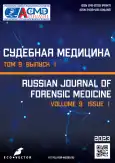Leading causes of death in older people and old age according to medical certificates of death in Moscow
- Authors: Kakorina E.P.1,2, Samorodskaya I.V.3, Cherniavskaia T.K.1
-
Affiliations:
- Moscow Regional Research and Clinical Institute
- The First Sechenov Moscow State Medical University (Sechenov University), Institute of Leadership and Health Care Management
- National Medical Research Center for Therapy and Preventive Medicine
- Issue: Vol 9, No 1 (2023)
- Pages: 29-40
- Section: Original study articles
- URL: https://journals.rcsi.science/2411-8729/article/view/133082
- DOI: https://doi.org/10.17816/fm753
- ID: 133082
Cite item
Full Text
Abstract
BACKGROUND: The proportion of older people is increasing worldwide. Leading causes of death must be understood for the organization of medical and social care.
AIM: This study aimed to identify and discuss the leading causes of death in older people and old age based on data from medical death certificates.
MATERIAL AND METHODS: From the electronic database of the Main Department of the Civil Registry Office of the Moscow Region (the system of the Unified State Register of Civil Status Records), all cases in which diseases were indicated as the initial cause of death (all codes of external causes, injuries, and poisoning were excluded) were selected. From a total of 109,126 deceased individuals, 90,269 (82.7%) were ≥60 years old. Eighteen groups of initial causes of death were made (95.2% of deaths from diseases); 40,442 (44.8%) medical death certificates were issued by the Bureau of Forensic Medicine.
RESULTS: Five leading causes of death were COVID-19 (24.2%), pathologies associated with cognitive impairment and dementia (21.15%; aged 60–69 years, 6.02%; aged ≥100 years, 63.5%), chronic ischemic heart disease (18.6%), malignant neoplasms (10.7%; aged 60–69 years, 16.7%; aged ≥100 years, 1.46%), and acute cerebrovascular accident (6.2%). The contribution of causes such as acute forms of coronary artery disease, stroke, hypertension, diabetes mellitus, COVID-19, and others is low in older people. Only 30% of the medical death certificates have their part II completed. The probability of filling out part II of the medical death certificate is influenced by age, place of death, place of issuance of the medical death certificates (in the Bureau of Forensic Medicine less than in other medical organizations), and teaching staff. With age, the proportion of MCAs issued by the Bureau of Forensic Medicine is increasing. Medical death certificates often use codes that are not analogous to clinical diagnoses.
CONCLUSION: The contribution of individual causes (and groups of causes) of death changes with age. For a better understanding of the leading causes of death, a multidisciplinary consensus is needed in determining the criteria and validity of the use of the International Statistical Classification of Diseases and Health-Related Problems, Tenth revision, codes.
Full Text
##article.viewOnOriginalSite##About the authors
Ekaterina P. Kakorina
Moscow Regional Research and Clinical Institute; The First Sechenov Moscow State Medical University (Sechenov University), Institute of Leadership and Health Care Management
Email: kakorina@list.ru
ORCID iD: 0000-0001-6033-5564
MD, Dr. Sci. (Med.), Professor
Russian Federation, Moscow; MoscowIrina V. Samorodskaya
National Medical Research Center for Therapy and Preventive Medicine
Email: samor2000@yandex.ru
ORCID iD: 0000-0001-9320-1503
SPIN-code: 6470-5709
MD, Dr. Sci. (Med.), Professor
Russian Federation, MoscowTatiana K. Cherniavskaia
Moscow Regional Research and Clinical Institute
Author for correspondence.
Email: corona1974@mail.ru
ORCID iD: 0000-0003-0227-8076
MD, Cand. Sci. (Med.)
Russian Federation, MoscowReferences
- Georgiopoulos GA, Lambrinoudaki I, Athanasouli F, et al. Free androgen index as a predictor of blood pressure progression and accelerated vascular aging in menopause. Atherosclerosis. 2016;(247):177–183. doi: 10.1016/j.atherosclerosis.2016.02.021
- Lakatta EG. So! What’s aging? Is cardiovascular aging a disease? J Mol Cell Cardiol. 2015;(83):1–13. doi: 10.1016/j.yjmcc.2015.04.005
- Drapkina OM, Samorodskaya IV, Larina VN. Challenges and prospects of preventive medicine at the primary level. Preventive Med. 2018;21(5):15–21. (In Russ). doi: 10.17116/profmed20182105115
- Weinberger DM, Chen J, Cohen T, et al. Estimation of excess deaths associated with the COVID-19 Pandemic in the United States, march to May 2020. JAMA Intern Med. 2020;180(10):1336–1344. doi: 10.1001/jamainternmed.2020.3391
- Timonin S, Shkolnikov VM, Andreev E, et al. Evidence of large systematic differences between countries in assigning ischaemic heart disease deaths to myocardial infarction: The contrasting examples of Russia and Norway. Int J Epidemiol. 2021;50(6):2082–2090. doi: 10.1093/ije/dyab188
- Drapkina OM, Samorodskaya IV, Yavelov IS, et al. Regional differences in mortality rates from cardiac causes in Russia: The role of statistical accounting features. Cardiovascul Therapy Prevention. 2021;20(7):2928. (In Russ). doi: 10.15829/1728-8800-2021-2928
- Monfared AA, Byrnes MJ, White LA, et al. Alzheimer’s disease: Epidemiology and clinical progression. Neurol Ther. 2022;11(2):553–569. doi: 10.1007/s40120-022-00338-8
- Doblhammer G, Fritze T, Reinke C, et al. Can dementia become the most prevalent disease at the time of death in Germany? Projections up to the year 2060 for the five most important diseases at the time of death. Population Ageing. 2022;15:523–540. doi: 10.1007/s12062-022-09365-7
- Aisanov ZR, Chuchalin AG, Kalmanova EN. Chronic obstructive pulmonary disease and cardiovascular comorbidity. Cardiology. 2019;59(8S):24–36. (In Russ). doi: 10.18087/cardio.2572
- López-Campos JL, Tan W, Soriano JB. Global burden of COPD. Respirology. 2016;21(1):14–23. doi: 10.1111/resp.12660
- Alter P, Kahnert K, Trudzinski FC, et al. Disease progression and age as factors underlying multimorbidity in patients with COPD: Results from COSYCONET. Int J Chron Obstruct Pulmon Dis. 2022;(17):1703–1713. doi: 10.2147/COPD.S364812
Supplementary files









